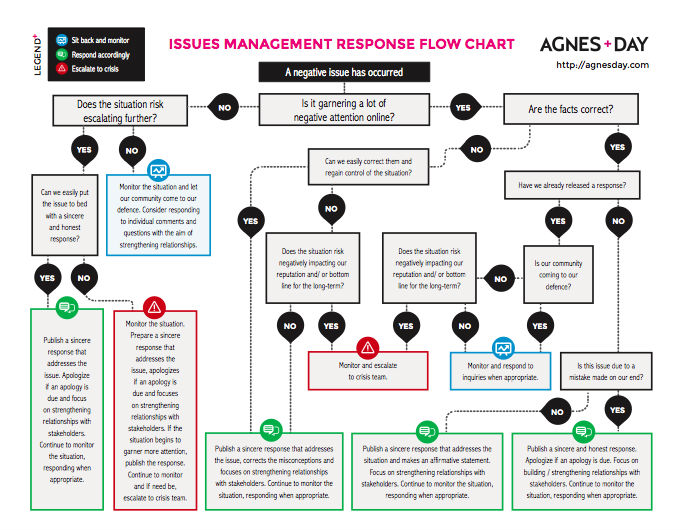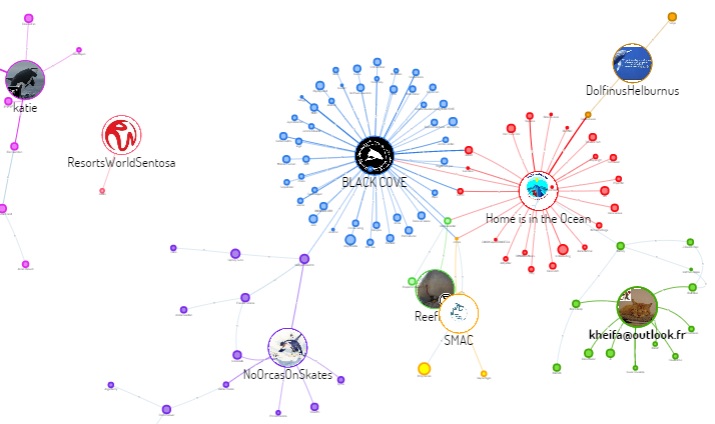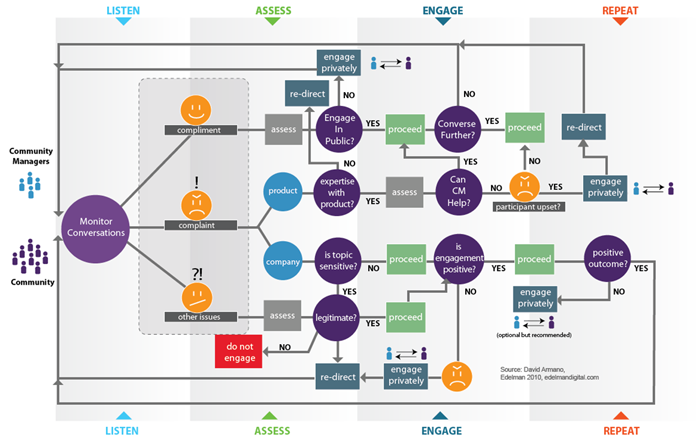15 Best Practices for Managing Your Online Reputation: Agents & Drivers
Online reputation is the single biggest challenge faced by brands and marketers, according to a 2015 study conducted by Brunswick Insights with over 200 communications directors.
And it's no surprise. With social media allowing consumers to share their experiences and opinions rapidly, a single encounter with a brand can impact its online reputation in minutes, even seconds. For marketing and communications professionals, these are the top 5 questions:
1. How do I analyze my online reputation?
2. What factors and actions should I consider?
3. Is my social media monitoring strategy comprehensive enough?
4. What should I do when my brand encounters negative buzz or feedback?
5. Do I have a potential crisis on my hands?
With this in mind, we've rounded up 15 best practices for managing your online reputation.
1. Build your internal communications network
A good online reputation management system rests on a reliable internal communications network. After all, the key to maintaining as much control as possible over your brand's image is to prepare before a potential event or driver, not react to it after, especially with conversations happening in real-time online.

Source: Agnes Day
An internal communications network should include the following:
- Key internal stakeholders
- Internal communications team to communicate the message across departments, as well as obtain information during crucial moments
- A listening dashboard with automated alerts for real-time updates, as well as aggregated reports that visualise the data clearly
- A clear flowchart that maps out every key person and course of action in all scenarios
2. Identify your organization's key internal stakeholders
Typically, your key internal stakeholders include your:
- CEO: As the head of the business, the CEO is by default the face of the company. He or she should be the first to receive news of a crisis brewing, as well as address it internally and externally.
- CMO/ PR and Communications Director: With a bird's eye perspective of the business, your CMO or PR Director should decide what to communicate, as well as when and where.
- HR: To ensure that internal teams are kept informed, as well as prevent potential leaks especially when it comes to product launches or technical problems.
- Regional and Local Heads: To keep local teams and markets informed about the situation.
- Product Teams: To provide the communications team with up to date information about products.
3. Map out your external influencers network
Another agent in a brand's online reputation is the influencer. Influencers are people who drive conversations on social media, whether it's brand specific or about a trending topic. Brands can identify them in two ways:
- As brand advocates who can spread the word on products services
- As potential hot spots during an online crisis

By mapping out their audience, as well as who they interact with, brands can ensure which influencer can truly drive the conversation, and which is merely occupying an "echo chamber".
4. Identify the potential drivers for your online reputation
Thanks to social media, brands no longer exist in a vacuum. With millions of conversations taking place, opportunities and crises can come a-knocking any time.
One way to prepare your communications network is to anticipate potential drivers such as:
- Product launches
- Technical failures
- Employee misconduct
- Viral sensations; how can brands hijack it and become part of the conversation?
5. Understand your organization's limits
An ongoing debate in PR and communications is whether to outsource it to an agency is or go in-house.
While PR agencies have an edge in terms of skills and technical knowledge in online monitoring, an in-house team would be more agile and connected to an organization's internal communications network.
6. Build a strong employer brand
"Employer branding" is not a new concept. With the rise of social media platforms such as Glassdoor enabling users to freely share working (and even interview) experiences with one another, brands need to be vigilant in the way they portray themselves not only to current employees but also prospective employees.
For example, is your company a fast-paced startup that thrives on ambitious, social media savvy employees? Or are you hiring for an established company that has honed its reputation as a steadfast, traditional institution over decades? Employers need to brand themselves accordingly so as to attract and retain the right talent.
7. Map your internal channels of communication
To keep employees informed and up to date about the latest developments and campaigns, employers can build an internal social network through three ways:
- Blogs
- Regular internal newsletters
- Intranet
8. Your employees = your brand
Thanks to social media, businesses and employees no longer exist in isolation. No matter the seniority, employee conduct on social media reflects directly on the brand, and sophisticated social listening can benefit HR departments in taking timely measures to identify employee advocates or mitigate potential crises in case of misdemeanors, especially at the frontline and executive levels.
Employee feedback on social media is another overlooked, yet nonetheless critical aspect of online reputation. Platforms like Glassdoor, where employee ratings contribute greatly to the perception of potential employees and partners provide a wealth of information. What remains is for HR departments to consolidate this feedback, together with the traditional avenues of quarterly or annual reviews and in-house employee surveys, and then respond with revised policies or other appropriate measures.
9. Establish a communications flowchart
Regardless of department, each and every employee is a potential touchpoint for a brand's customer. Organisations would benefit from drawing a clear flowchart for employees to follow, in terms of who to get information from, what can or cannot be communicated to the public, and what measures to take in different scenarios.

10. Establish a rule-book for your employees
As the saying goes, prevention is better than cure. Brands can mitigate the repercussions of an online crisis by anticipating potential issues, as well as ensuring that their employees are clear on what can and cannot be shared with the public. This is especially important for tech companies, where key product developments must be kept confidential until the official launch date, in order to avoid imitation by competitors.
11. Defining "reach" for your brand.
Begin with the end in mind and ask these questions:
- What kind of reach are you considering? Organic or paid?
- Which social media platform are you trying to reach?
- Are you considering owned or earned media, or both?
When analyzing reach, it is also important to look beyond vanity metrics, such as a number of retweets/shares of a certain post or article. After all, sharing or re-tweeting is not indicative of whether the user has fully read and digested the content.
It is also important to consider that not all shares are equal - for example, a news website would reach more people than a Twitter user because the former commands a higher readership online than an ordinary customer who is merely sharing his or her experiences.
12. Considering earned media
It goes without saying that earned media is crucial in expanding a brand's reach. These include:
- News articles
- Consumer reviews on forums like TripAdvisor and Yelp!
- Content shared on social media
As Richard Branson said, your brand is not what you say it is, but what people say it is. Often, customers are trawling through peer reviews and articles before deciding to purchase a particular product or service, and brands would do well to ensure that these "earned media" are reaching customers with the most favorable angle.
13. The power of images
Thanks to the rise of platforms such as Instagram, Pinterest, Snapchat, and Tumblr, photo and video sharing has become more pervasive than ever - and this trend will continue to grow as social media channels evolve to include messaging and live video functions.
For these brands, this presents a challenge in terms of social listening. As social media users rely more and more on photos and videos to share their experiences, how can marketers maintain a 360 view of their online reputation, without textual references like captions to indicate a brand's presence in a particular posting? How does the appearance of a logo, product or service in a photo or video contribute to the overall image of a brand?
Thus, it is important to integrate technology that can help to recognize certain brand symbols and logos, into one's existing social listening suite.
14. Thinking of using influencers for your next campaign?
Whether you're a new brand that is trying to gain exposure, or an established one looking to better engage one's customers online, influencers are a valuable asset for communicating your brand's story to their audience.
The trick is to identify the right one for your brand, and this depends on the following:
- Number of followers
- Number of engaged followers
- Are their content and image in line with what you are selling?
15. Establishing your brand as an industry leader.
Besides using influencers, brands can further connect with their customers by establishing themselves as an industry leader. This applies to both B2C and B2B brands, where customers are increasingly attracted to brands that appear invested in their interest, not just to sell. Good content and social selling by a company's top management are just some of the ways brands can build their "thought leadership."
Written by Melissa Chue
Melissa is a digital advocate who loves diving into the latest trends in digital and social media. Since joining Digimind’s marketing team in 2015, she has written studies for over 15 industries in Asia Pacific. When she is not telling stories about data, Melissa can be found exploring her favourite cafes and hangouts on Instagram @chuepachups.

